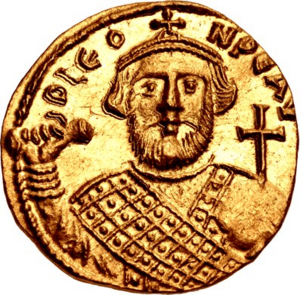Leontius facts for kids
Quick facts for kids Leontius |
|||||
|---|---|---|---|---|---|
| Emperor of the Romans | |||||

Leontius in imperial clothing, shown on a coin called a solidus.
|
|||||
| Byzantine emperor | |||||
| Reign | 695–698 | ||||
| Predecessor | Justinian II | ||||
| Successor | Tiberius III | ||||
| Born | Isauria | ||||
| Died | c. 15 February 706 Constantinople |
||||
|
|||||
| Father | Lazarus (?) | ||||
Leontius (Greek: Λεόντιος, romanized: Leóntios; died c. 15 February 706) was a Byzantine emperor who ruled from 695 to 698 AD. The Byzantine Empire was the eastern part of the old Roman Empire. We don't know much about his early life, except that he was born in a place called Isauria in Asia Minor.
Leontius was a very skilled general. He was given important titles like patrikios (a high-ranking noble) and strategos (a top military commander) of the Anatolic Theme, which was a major military region. He led armies against the Umayyads, who were a powerful Islamic empire. He won battles and forced their leader, Abd al-Malik ibn Marwan, to make peace.
However, Emperor Justinian II started another war in 692. Leontius was sent to fight, but his army was badly defeated at the Battle of Sebastopolis. Because of this failure, Justinian II put Leontius in prison.
In 695, Leontius was set free. He was given a new job as strategos of the Theme of Hellas in Southern Greece. Soon after his release, he led a rebellion against Justinian II. He managed to take control and became the new emperor that same year.
Leontius ruled for three years until 698. He was then overthrown by a naval commander named Apsimarus. Apsimarus had been part of a failed mission to get back the city of Carthage. After taking Constantinople, the capital city, Apsimarus changed his name to Tiberius (III). Leontius was sent to a monastery and stayed there until 705 or 706. By then, Justinian II had returned to power. Both Leontius and Tiberius were executed.
Becoming Emperor
We know that Leontius came from Isauria, but not much else about his early life. He was made strategos of the Anatolic Theme by Emperor Constantine IV. This was the most important military job in the Byzantine Empire at the time.
Around 680 AD, the Islamic Umayyad Caliphate was going through a civil war. This made them weaker, and the Byzantine Empire saw a chance to attack. In 686, Emperor Justinian II sent Leontius to invade Umayyad lands in Armenia and Iberia. Leontius was very successful and gathered a lot of treasure. His victories made the Umayyad leader, Abd al-Malik, ask for peace in 688. They agreed to pay the Byzantines money and goods every week.
In 692, Justinian II decided to attack the Umayyads again, thinking they were still weak. But the Byzantine army was defeated at the Battle of Sebastopolis. Many soldiers from the Slavic tribes switched sides during the battle, which led to the Byzantine loss. After this, the Umayyads attacked North Africa and Anatolia. Around this time, Justinian II put Leontius in prison. Some historians think Justinian believed Leontius wanted to take the throne. It's also possible that Leontius's defeat at Sebastopolis played a part in his imprisonment.
Justinian II released Leontius in 695 because he was worried about losing Carthage. He made Leontius strategos of the Theme of Hellas in Southern Greece. While in prison, two monks had told Leontius that he would become emperor. They encouraged him to rebel against Justinian II after he was freed.
Leontius quickly started a rebellion. He had a lot of support from important families (the aristocracy) who didn't like Justinian's land rules. Peasants also supported Leontius because they didn't like Justinian's taxes. Even the Blue faction from the Hippodrome and the leader of the church, Patriarch Callinicus, supported him. Leontius and his supporters captured Justinian II. However, Leontius did not kill him out of respect for Justinian's father, Constantine IV. Instead, Leontius sent Justinian II away to Cherson, a Byzantine area in the Crimea.
Rule and Overthrow
After becoming emperor, Leontius tried to be a fair ruler. He focused on making the empire stronger from the inside. He didn't let the Byzantine army attack other lands much. Instead, he worked on fixing problems within the empire. One thing he did was clear out the port of Neorion in Constantinople. This was followed by a four-month outbreak of a serious illness called the plague.
The Umayyads saw Leontius's focus on internal matters as a sign of weakness. In 696, they invaded North Africa and captured Carthage in 697. Leontius sent a general named John to get the city back. John managed to take Carthage back with a surprise attack. But then, more Umayyad soldiers arrived and took the city again. John had to retreat to Crete to plan his next move.
A group of officers, worried about being punished by the emperor for their failure, rebelled. They declared Apsimar, a naval commander, as the new emperor. Apsimar took the name Tiberius. He gathered a fleet of ships and allied with the Green faction in Constantinople. He then sailed to Constantinople, which was suffering from the plague. After a few months of fighting, the city surrendered to Tiberius in 698.
Tiberius captured Leontius and put him in the Monastery of Dalmatou. Leontius stayed there until 705. In that year, Justinian II, who Leontius had exiled, managed to get his throne back with help from the Bulgar king Tervel. Both Leontius and Tiberius were executed on February 15, 706. Leontius's body was thrown into the sea, but it was later found and buried in a church on the island of Prote.
See also
 In Spanish: Leoncio para niños
In Spanish: Leoncio para niños

